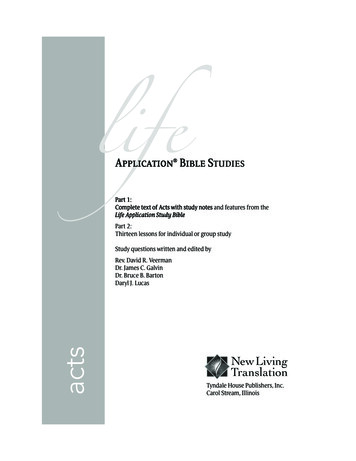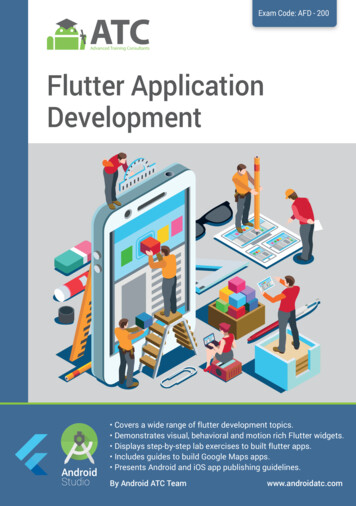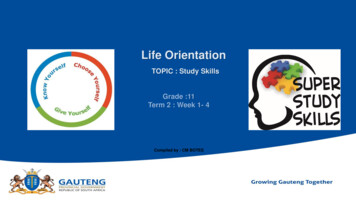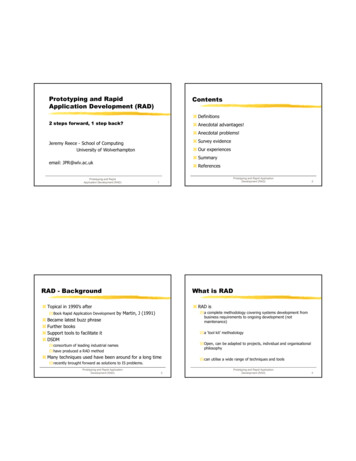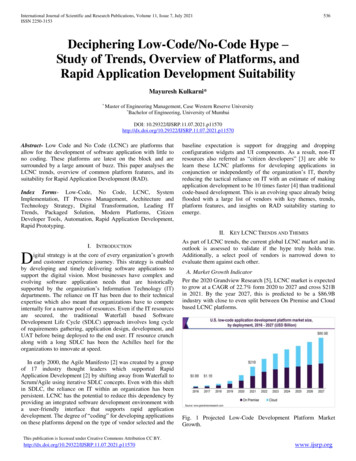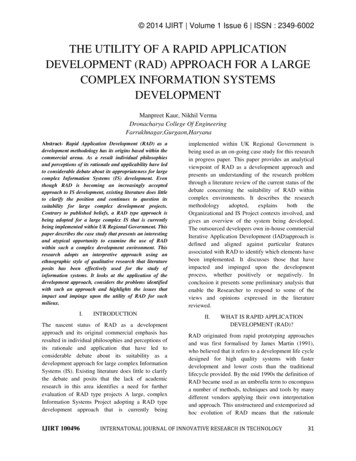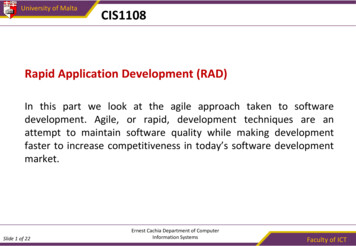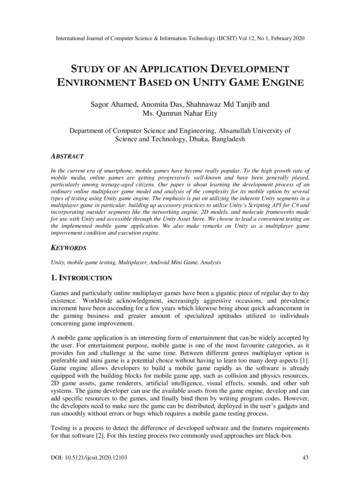
Transcription
International Journal of Computer Science & Information Technology (IJCSIT) Vol 12, No 1, February 2020STUDY OF AN APPLICATION DEVELOPMENTENVIRONMENT BASED ON UNITY GAME ENGINESagor Ahamed, Anomita Das, Shahnawaz Md Tanjib andMs. Qamrun Nahar EityDepartment of Computer Science and Engineering, Ahsanullah University ofScience and Technology, Dhaka, BangladeshABSTRACTIn the current era of smartphone, mobile games have become really popular. To the high growth rate ofmobile media, online games are getting progressively well-known and have been generally played,particularly among teenage-aged citizens. Our paper is about learning the development process of anordinary online multiplayer game model and analysis of the complexity for its mobile option by severaltypes of testing using Unity game engine. The emphasis is put on utilizing the inherent Unity segments in amultiplayer game in particular, building up accessory practices to utilize Unity’s Scripting API for C# andincorporating outsider segments like the networking engine, 2D models, and molecule frameworks madefor use with Unity and accessible through the Unity Asset Store. We choose to lead a convenient testing onthe implemented mobile game application. We also make remarks on Unity as a multiplayer gameimprovement condition and execution engine.KEYWORDSUnity, mobile game testing, Multiplayer, Android Mini Game, Analysis1. INTRODUCTIONGames and particularly online multiplayer games have been a gigantic piece of regular day to dayexistence. Worldwide acknowledgment, increasingly aggressive occasions, and prevalenceincrement have been ascending for a few years which likewise bring about quick advancement inthe gaming business and greater amount of specialized aptitudes utilized to individualsconcerning game improvement.A mobile game application is an interesting form of entertainment that can be widely accepted bythe user. For entertainment purpose, mobile game is one of the most favourite categories, as itprovides fun and challenge at the same time. Between different genres multiplayer option ispreferable and mini game is a potential choice without having to learn too many deep aspects [1].Game engine allows developers to build a mobile game rapidly as the software is alreadyequipped with the building blocks for mobile game app, such as collision and physics resources,2D game assets, game renderers, artificial intelligence, visual effects, sounds, and other subsystems. The game developer can use the available assets from the game engine, develop and canadd specific resources to the games, and finally bind them by writing program codes. However,the developers need to make sure the game can be distributed, deployed in the user’s gadgets andrun smoothly without errors or bugs which requires a mobile game testing process.Testing is a process to detect the difference of developed software and the features requirementsfor that software [2]. For this testing process two commonly used approaches are black-boxDOI: 10.5121/ijcsit.2020.1210343
International Journal of Computer Science & Information Technology (IJCSIT) Vol 12, No 1, February 2020testing and white-box testing. However, the approach to test a mobile game can be different fromthe common software.In this study, our aims to learn the development process of the online multiplayer game onmultiple platforms using unity game engine. And analysing the complexity with the help ofdifferent types of testing and scripting enabled between any four devices. So, the users of same ordifferent devices running on same or different platforms can play with each other.This paper is organized as follows: Section II gives an introduction of the background studiessuch as, Android Studio, Unity, PUN and the Google Play Games Services. Section III presentsdetails about the mobile game application. In Section IV, we discussed about the various tests andanalysis of the application. Finally, section V provides a conclusion and some slight details offuture work.2. BACKGROUND STUDIESWe have studied many topics beyond what we need to analyse and test. For analysis and testingwe have studied unity, android studio and other essential components, which are described below.2.1. Android StudioThe official IDE for Google’s android operating system is Android Studio. It is a product madeby Google through which one can make android applications. One can survey how the interfaceof application looks like and what changes are required as it comprises of realistic design. Itprovides various benefits when building Android apps to provide with automation testing servicessuch as: It is a versatile Gradle-based system.It is a feature-rich emulator.Android studio is a uniform environment where we can develop for all Android devices.It has broad testing instruments and structures.Easy to assimilate GCM.Android studio has a lot of features & functions, but for this experiment we have just learned andexplored a few of them. Those are given below.2.1.1. Android Alert DialogIt is used to display the dialog message with OK and Cancel buttons also to break and ask the userabout his desire to retain or discontinue.2.1.2. Countdown TimerIt is used to set a countdown based on interval and it will stop when the time has come in future.2.1.3. BundlesBundles are typically used for passing data between different Android activities. Depending onthe types of need, bundles can hold all types of values to pass them to another activity.2.1.4. Shared PreferenceOne of the most interesting data storage option in Android Studio is Shared Preferences. It allowsactivities and applications to save and recover small amounts of primeval data that will preserveeven if the user closes the app.44
International Journal of Computer Science & Information Technology (IJCSIT) Vol 12, No 1, February 20202.1.5. ToastToast is an expedient way to display information or prompt messages for a time span to user.After timeout, it also disappears automatically.2.1.6. Handling Click events in ButtonIn Android Studio there are two ways to handle the click event after the button click. Onclick in xml layout: If any user clicks a button, button object receives an on clickevent.OnClickListener: The click event handler can also be declared programmatically. This isthe most preferred way because it can be used in both Activities and Fragments.2.1.7. Supporting Different Screen Sizes and Pixels DensityAs android runs on a variety of devices that have different screen sizes and pixel densities. Wehave used different drawable for adopting different screen sizes.2.1.8. Android Studio EmulatorAndroid Studio has a default emulator that works just like a real Android device. So those who donot have an Android device do not have to face any problem.2.2. UnityUnity is a cross-platform game engine with a built-in IDE. It is the most powerful, full featured,business multi-platform 2D and 3D game development device made by means of UnityTechnologies [3]. Basically, it is used for broadening video games for web plugins, computerplatforms, consoles and cellular devices. It has the best community support.The Asset Store of unity is rich.It is a scripting Language.This game engine has the ability to create Multiplayer game.It is very easy to study and execute unity.Like Android studio, Unity also has a lot of features & functions, but for this experiment we justlearned and explored a few of them. Those are given below.2.2.1. GraphicsStunning images are provided by unity game engine. It also enables to facilitate the productionimporting assets from one-of-a-kind platforms. So that users must not wait lots of time with everyimport.2.2.2. GUICreators with tools are provided by unity game engine to build its own graphics user interfaces,such as buttons and drop-down menus, sliders and manner of combining different interactableelements.2.2.3. ScriptingAdditional game-unique behaviours are required in video games. These behaviours may beimplemented programmatically in unique components called Scripts by the use of Unity’s45
International Journal of Computer Science & Information Technology (IJCSIT) Vol 12, No 1, February 2020Scripting API (C#, JavaScript or Boo). The most common methods observed in Scripts areAwake(), Start() and Update().2.2.4. CoroutineA coroutine is like a function. An execution can be paused and control can be returned to Unityby this tool.2.2.5. Canvas ScalerThis component is useful to control the overall scale and pixel density of UI. It also fits thesmallest resolution of computer image. Though pixel size depends on user’s screen resolution butpixel lighting is calculated at every screen pixel.2.2.6. PlayerPrefsIt is a useful utility which is accessed like a dictionary (key/value pair) to persist certain types ofdata between scenes. It isn't encrypted, so sensitive things shouldn't be stored using this. It is veryuseful for storing user preferences or configuration.2.2.7. Static InstanceThis helps to access any function and public variable of this manager class from any other script.2.2.8. PlatformsUnity is a cross-platform game engine and used to develop games for PC, consoles, mobiledevices and websites, as it supports deployment to multiple platforms [5].2.3. Photon Unity NetworkingPUN (Photon Unity Networking) is a Unity package for online Multiplayer games which alwaysconnects to a dedicated server. It provides rooms, flexible matchmaking and in-roomcommunication for players. It is very easy to use & export to basically all platforms supported byunity. It is available in two options, Pun free (20 CCUs) and the Pun Plus (100 CCUs). Our gameuses the free version of PUN v2 [6].Rooms and lobbies are two main concepts of PUN. Here connecting to a lobby means connectingto a session server, while connecting to a room corresponds to connecting a game server. Whichmeans that a player must have to connect with a lobby first before connect to a room. The playerjoins a lobby after successful authentication. Then they can create or join a room. Photon serverprovides a means of sending data from one client to the other available clients and uses PUN tosynchronize the game state between themselves. The Following synchronization mechanisms isused to achieve this communication: PUN RPCs (Remote Procedure Calls), Custom roomproperties and etc.2.3.1. PUN RPCsThis provides an easy way to synchronize events between clients by allowing calling a scriptmethod on another client. This method calls on remote clients in the same room.46
International Journal of Computer Science & Information Technology (IJCSIT) Vol 12, No 1, February 20202.3.2. Custom Room PropertiesIt is used as key-value pairs to synchronize values that do not belong to any objects. It shows away to share values across room that player is currently in without having to have any referenceto a specific item. Player’s icon can be set in a custom property and other players could grab thatcustom property without having any reference to this player.2.3.3. RaiseEventRPCs (Remote Procedure Calls) needs a PhotonView and a method to be called as RPCs aren’texactly what is required for game events. So, it is used to make up own events and send themwithout any relation to some networked objects.2.4. Play Games ServicesSome elements such as, high scores, cloud save, leader boards, quests, and other supports arerequired for the implementation of developing a game for the Android platform. Adding thesefeatures to the game will help keep players more engaged. Instead of doing it manually, it can bedone with Google Play games services APIs.Google Play Games Services [7], Provides a range of ready to use features that can be added to agame by using a simple API. In addition, the APIs and tools will reduce the burden of testing,managing, and publishing a game. The comprehensive reporting and statistics will track andimprove games performance.2.4.1. Sign inIn order to access Google Play Game Service functionality, a game desires to offer the signed inplayer’s account. If the player isn’t authenticated, the game may encounter errors when makingcalls to the APIs.2.4.2. Unlocking AchievementsWith achievements, players may be retained by way of adding rewards for engaging in set goalsin the game. Players can earn experience points for conducting achievements. It can be a brilliantmanner to grow the user’s engagement with game.2.4.3. Posting score to leaderboardPlayers get a scope to evaluate their scores with friends and compete with eminent players withleader board.2.4.4. Saved Games serviceBy using this the game can retrieve the stored game records to permit returning players tocontinue a game with the last gained games data such as scores, levels, etc. from any device. Ithelps to concur a player’s game data via multiple devices and ensures that players can continuegame play from where it left off.3. EXPERIMENTAL DEVELOPMENT OF AN APPLICATIONDescription of features and functionalities of the target system that can be hidden or obvious,expected or unexpected, known or unknown from client’s point of view is needed. So, after thebackground study we understand that Unity is specially developed to be good at handling graphic47
International Journal of Computer Science & Information Technology (IJCSIT) Vol 12, No 1, February 2020assets, animations, sound assets etc[4]. Which also allow to run the game inside the game editor.Developer can also change the properties of the game assets directly and view the resultsimmediately, even when running the game. But, for building a game on a tool like AndroidStudio, we need to develop most of such possibilities by ourselves. As Unity provides moreflexible & better performance for android game development than Android Studio. That's why wedecide to keep our testing and analysis progress only on Unity. So, we've implemented &improved our game by adding different kinds of features in unity which helped us in the analysisand testing part. The detailed description of our game is given below.3.1. Summary of the Experimental Development Game Name: Catch the Culprit.Game Genre: Card.Platform: Android.3.2. Game CharacteristicsCatch the Culprit is a popular local game of Bangladesh which is played by every people of thecountry in their childhood. It is typically known as "Thief, Robber, Master and Police". The gameconsists of four players and there is a card for each player from where each player has to pick onecard. The interesting fact here is that in the first round who gets the police card will have topredict the thief. For the next round the police would have to assume who is the robber among theplayers. If a police card player makes the right prediction, he will get points, otherwise the otherplayer will get points. In this way the game will continue in phases. The players can take threetypes of challenges in the game: Time challenge, Score challenge and Level challenge.3.3. Graphic Concept Art:Some of the graphic concept art used in the game are discussed in (e.g. Table 1).Table 1. Game Character Designing and Modelling.DescriptionThese icons appear according to thechallenge type when a player starts playinga single challenge. It indicates the time,level, score that has flowed.ImageFigure 2. Indicators.These are the different methods for coincollection which is required for multiplayergame play.Figure 3. Different ways for collecting coins.Different types of cards which will berevealed in the game during game play. Thefirst card appears in the row represents theback of all the cards. The second card is theunknown card which appears when a playergets thief or robber card. Then comesrespectively the master card, the policecard, the robber card and the thief card.Figure 4. Different types of cards.48
International Journal of Computer Science & Information Technology (IJCSIT) Vol 12, No 1, February 2020This wheel indicates the number of player’sturn. The wheel of serials helps to decidewhich player will play first.Figure 5. The wheel of serials.While playing each player can sendemoticons to others. Also, someconventional words are included here withthe emoticons which are commonly usedduring play.Figure 6. Emoticons box.Individual game details will be displayedhere when the game starts. Such as, Name,Serial, turn time, Emoji's send button.Figure 7. Profile indicators.The treasure box is for collecting coins.When the box is ready to be opened, theplayer can collect the coins by clicking onthe box. Then a random number of coinsfrom the box will be deposited with thetotal coins. After collecting the coins, thebox will be closed again for one hour.Figure 8. Phase of coin collectionTable 2. Animation.We have applied animation to the treasure box, coins and cards using JavaScript’s C\# andsprite sheet. We can use transition animation, assign keys to open the treasure box, movementof the coins or card flipping.Table 2. Interface.The menu was designed in Adobe Photoshop and animation. There is a background sound forthe game which can be turned on or off by the user3.4. Core Idea of the GameA player can play the game in three ways.49
International Journal of Computer Science & Information Technology (IJCSIT) Vol 12, No 1, February 2020 Multiplayer: A real-time turn-based play on the server with random / selected opponentson their own respective devices.Single: An individual play with computers able to pick random moves and decisions.Four Player: Four players involved in one game playing in the same device.The flow chart of the working game is presented in Figure 1 below.Figure 1. Game flow chart3.5. Game DevelopmentWe tried to create a native card & board game as our experimental development. Detaileddescription of our Game UI and Gameplay is given below.3.5.1. Game UI ScreenStart MenuThis is the first interface when the game is executed. There are about fifteen characters fromwhich a player can select his desired profile picture. He has to input what nick name he/she wantsto use for playing. After saving information’s another screen appears which is called main menu.Figure 9. Game Menu.Main MenuThis is the main menu interface of the game (Figure 9). Player can update his profile name andimage, collect coins, rate the app and can proceed to play the game in different modes from here.50
International Journal of Computer Science & Information Technology (IJCSIT) Vol 12, No 1, February 2020Total earned coin by the player will always be appeared on the right side of the screen. The staroption which is placed above it, is for storing multiplayer game scores only. None of the offlineplay scores will add here.ProfileFrom the information of Start menu, the name and character image of the player appears on thetop right. If the player wants to change the name or image given earlier, he has to click on theimage where he can update the name and image. Above the local name, another name appearswhich is given by the Google Play games services.Online MultiplayerIn online multiplayer game, a player can create a room or can join in an existing room. Themaster client needs to select a playable mode and the game's play range. After joining 4 membersin the room, the master client can start the game (Figure 10).Offline playIn offline play, the player has to select if he wants to play with CPU or four friends. If he selectsthe CPU, he will start playing as player1 where the remaining three competitors will be computercontrolled and will do random actions. If he wants to play with his friends using same device, hecan select 4 players.SettingsThere are two options here. Using the first option, the player can turn on/off the game sound. Andanother is for Logout from the GPGs sign in.Figure 10. Online multiplayer game play.51
International Journal of Computer Science & Information Technology (IJCSIT) Vol 12, No 1, February 2020Score BoardThe score board which appears after finishing the game. Here all the players are placed inascending order according to their score. The interesting fact is, every player can see their scorehighlighted in their own screen (Figure 11).Figure 11. Final Score Board.Leader BoardsThe button that placed before the treasure box shows how many times the player has taken thetime challenge, score challenge and level challenge. There is another button named leader boardwhere the player's highest earned scores can be seen. By clicking the achievement button, playercan see the unlocked achievements.3.5.2. Gameplay DescriptionDetailed description about gameplay is given below.3.5.2.1 Multi PlayerFor playing multiplayer games, the player who creates a room or starts the game is called masterclient. Clicking on Online Multiplayer button will bring up two options, Create Room and JoinRoom. If the player clicks on the option named Create Room, the next appeared screen will askhim to select the game challenge type. The players can take three different challenges. Time challenge: In this challenge, a certain period of time will be determined by theplayers. Whoever gets the highest number after the end of certain time will win.Score challenge: In this challenge, the highest achievable points are assigned by theplayers. The player who first earns the assigned points wins.Level challenge: In this challenge, the player has to determine how much level he iswilling to play. The player who gets the highest number at the end of the specified levelwill win.After selection, a master client has to fill up the text box with his expected time, points or level.Then the interface of room creation will appear where the player has to enter the room name andthus the room will be created. Then, the room name will be displayed to other ready players [9].Other players can join the room in three ways. One can join room by choosing from the roomwhich is available in the rooms list or by manually type the name of the created room. The otherway is by clicking on the "Join random" button. Then if the master player gets four players who52
International Journal of Computer Science & Information Technology (IJCSIT) Vol 12, No 1, February 2020have joined his room then he can start the game. After that, master client spins the wheel ofserials which will determines the serial number of the players. Then the game will begin.After that, the gaming interface will appear. Each player has their turn highlighted on theinterface so they can easily understand when their turn comes. Every time an arrow indicatorcomes up to the screen to show whose turn it is. The game will automatically start after few secs.There is a card for each player. The cards will be randomly arranged in the game and will beshuffled again after completion of a round. When the game starts, 4 cards appear in the middle.Players can choose any of them. Once a player selects his card, the card will be displayed on thescreen to every player if the player gets the Master or the police card. Thus, the rest will selecttheir card. One card reduces each time. The other two cards except Master and Police will beinvisible to all but the player himself can see his card. If a player does not play his moves within20 seconds then auto move will be activated. A card will be randomly selected for that player.In the first round who gets the police card will have to predict the thief. If the prediction iscorrect, police gets 80 points and the thief will get zero. If the prediction is incorrect vice versawould happen. For the next round the police would have to assume who is robber among theplayers. The player with the master card will get 100 points directly. The points fixed for the thiefand robber is respectively 40 and 60. If the player who got the card of police doesn’t selectanyone on time, he will get minus 50 points. In this way the game will continue in phases. Thehighest scoring player in the first level will get the chance to play his move first in next level.The final score board (Figure 12) will come up when the game ends, where the highest scorer willbe on the top and the rest of the players will be there in ascending order according to their scores.3.5.2.2 Single PlayerWhen this option is selected, a screen appears with three options named time, score and levelchallenges. The player has to input the expected time, score or level to be played. Then the gamewill start with three opponents controlled by the computer and they will perform random actions.3.5.2.3 Four PlayerThree options like Single player appears for this option also. But the difference is in this modeplayer can play with real players in same device.4. EVALUATION OF APPLICATIONNowadays smartphones have become a part of our everyday activities, so testing mobile apps hasbecome important. Testing is a process to verify the features of a software and is done to showthat the system is working or not. Although it is expensive and time-consuming, it ensures ourcustomers have a positive experience when using our mobile app. In general, software testing is aset of activity conducted to check whether the actual results match with the expected results andconfirming that the software component is defect free. The software which is currently undertesting must provide all the defined functionalities and match the required workflows. Betweendifferent testing approaches, two commonly used process are black box testing and white boxtesting [8]. However, mobile game testing can be different from the software testing.Mobile game usually builds of interacting sub systems and continuous game loop. Mobileapplication testing is procedure to test functionality, usability and consistency glitches of anapplication software developed for handheld mobile devices. In this paper, we conduct a series ofactivities for mobile game testing. As we develop the game on unity game engine, the studyutilizes the testing "Unity Test Runner" available in the engine. Unity testing will identify if there53
International Journal of Computer Science & Information Technology (IJCSIT) Vol 12, No 1, February 2020exist errors in the structural level of the code. Our primary goal for this testing efforts was to findthe existing errors in the game.Factors of Mobile App Testing EmulatorsReal Mobile devices.4.1. Types of Mobile Apps TestingFor game testing several techniques can be applied. But, as we are specifically focusing onmobile games testing, the types of testing methods are shown in.4.1.1. Unit TestingWe design a unit test to test a single unit of code. And we also determine that, whether it behavesexactly as same as our expectation for small, logical, snippet of codes. In unity, Unity Test isperformed through Unity Test Runner.4.1.1.1 Unit Test RunnerThe component provides test runner to execute test case and report the results (Figure 12). Thistool can be used to test code in both Edit mode and Play mode. This page [10] helped to us getstarted and understand the basics Unit Testing concept.Figure 12. Unity Test Runner.4.1.1.2 The ExperimentsThe tool exploration has been performed on the game source code and makes it as the test subject.Normally test are divided into some parts. The general structure of this test is given below. Arrange: In the arrange part we prepare the tests. And setup the prime configuration thereso that we can create dependent object and defined the preconditions and inputs.Act: In the act part, we called the methods of the test class.Assert: In the Assert phase we ensure that our expectations are met. We assert that theexpected results have occurred in the range part of our test.The source code that has been modified using the above-mentioned rules in order to generate testcase.54
International Journal of Computer Science & Information Technology (IJCSIT) Vol 12, No 1, February 2020After applying the rules to the source code, the next steps are: Instantiate the tested class.Instantiate the Test Suite (set of test cases) class.Initialize the variable value.Call the tested method, which is Start method.Use Assert related functions to check if the expected result equals the real result.The environment for testing process is as follows:Hardware specification: Processor: Intel(R) core (TM) i5-5200U CPU @ 2.20 GHz.Memory: 8.00 GB RAM.SSD: 256 GB.Software specification: OS: Windows 10 Education.Tools: Unity, Unity Test Runner, Visual Studio, Nox player.Programming Language: C#.4.1.1.3 Results & DiscussionsWe reviewed each class and methods and prepared some methods for the test cases. The criteriafor selecting the methods is on the fact that other methods interact with game engine sub systems.As because the dependency with other game resources and results domain is very large thesemethods can’t be easily tested using the Test tool. The process of testing the test cases: Theauthors can conclude that the methods are bugs free as marked by the green check mark in thetesting results.Figure 13. Test cases run on Unity Test Runner.The authors also tried to test whether the test cases are reliable or not by entering inputs that donot match for the required condition during the testing process. And Test runner shows that thetested methods was not bugs free.55
International Journal of Computer Science & Information Technology (IJCSIT) Vol 12, No 1, February 2020Figure 14. Test cases run on Unity Test Runner with errors condition.4.1.2. Functionality TestingIt’s a type of testing to ensure that mobile applications are working as per the requirements. Sowe did it by inserting the input and examining the output. Some examples are: We have ensured easy login using GPGs.Test to make menu options easy to find.We test it to see if the app works well with a smartphone screen keyboard.Manage data handling, storing and avoid data deletion. And many more.4.1.3. Regression TestingThis test is basically, re-testing unchanged parts of the app. During the entire testing process, wemake sure of that a recent code change has not adversely affected exi
This game engine has the ability to create Multiplayer game. It is very easy to study and execute unity. Like Android studio, Unity also has a lot of features & functions, but for this experiment we just learned and explored a few of them. Those are given below. 2.2.1. Graphics Stunning images are provided by unity game engine.
